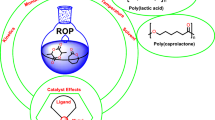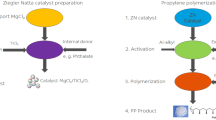Abstract
Yttrium and lanthanum amido-complexes with bis(pyrazol-1-yl)acetates in their coordination spheres were studied as the catalysts in ε-caprolactone and lactide ring-opening polymerisation. A high molecular mass poly(ε-caprolactone) (PCL) was obtained in almost quantitative yield under mild conditions. rac-Lactide polymerisations were less efficient and required quite harsh experimental conditions to obtain atactic PLA samples with moderate yields. The average chain-length of PCL was dependent upon the choice of the metal centre and the presence of substituents on the pyrazole rings of the ancillary ligand. The ground-state geometries of the complexes and the first stages of ε-caprolactone polymerisation were computationally modelled by means of DFT calculations.
Similar content being viewed by others
References
Amgoune, A., Thomas, C. M., & Carpentier, J. F. (2007). Controlled ring-opening polymerization of lactide by group 3 metal complexes. Pure and Applied Chemistry, 79, 2013–2030. DOI: 10.1351/pac200779112013.
Arnold, P. L., Buffet, J. C., Blaudeck, R. P., Sujecki, S., Blake, A. J., & Wilson, C. (2008). C3-symmetric lanthanide tris(alkoxide) complexes formed by preferential complexation and their stereoselective polymerization of rac-lactide. Angewandte Chemie International Edition, 47, 6033–6036. DOI: 10.1002/anie.200801279.
Beck, A., Weibert, B., & Burzlaff, N. (2001). Monoanionic N,N,O-scorpionate ligands and their iron(II) and zinc(II) complexes: Models for mononuclear active sites of non-heme iron oxidases and zinc enzymes. European Journal of Inorganic Chemistry, 2001, 521–527. DOI: 10.1002/1099-0682(200102)2001:2<521∷AID-EJIC521>3.0.CO;2-Q.
Bortoluzzi, M., Paolucci, G., Fregona, D., Dalla Via, L., & Enrichi, F. (2012). Group 3 and lanthanide triflate-complexes with [N,N,O]-donor ligands: synthesis, characterization, and cytotoxic activity. Journal of Coordination Chemistry, 65, 3903–3916. DOI: 10.1080/00958972.2012.728591.
Bradley, D. C., Ghotra, J. S., & Hart, F. A. (1973). Low co-ordination numbers in lanthanide and actinide compounds. Part I. The preparation and characterization of triss(trimethylsilyl)amidolanthanides. Journal of the Chemical Society, Dalton Transactions, 1973, 1021–1023. DOI: 10.1039/dt9730001021.
Brandolini, A. J., & Hills, D. D. (2000). NMR spectra of polymers and polymer additives. New York, NY, USA: Marcel Dekker.
Burzlaff, N., Hegelmann, I., & Weibert, B. (2001a). Bis(pyrazol-1-yl)acetates as tripodal “scorpionate” ligands in transition metal carbonyl chemistry: syntheses, structures and reactivity of manganese and rhenium carbonyl complexes of the type [LM(CO)3] (L = bpza, bdmpza). Journal of Organometallic Chemistry, 626, 16–23. DOI: 10.1016/s0022-328x(01)00648-9.
Chamberlain, B. M., Sun, Y., Hagadorn, J. R., Hemmesch, E. W., Young, V. G., Jr., Pink, M., Hillmyer, M. A., & Tolman, W. B. (1999). Discrete yttrium(III) complexes as lactide polymerization catalysts. Macromolecules, 32, 2400–2402. DOI: 10.1021/ma990005k.
Claridge, T. D. W. (2009). Diffusion NMR spectroscopy. In T. D. W. Claridge (Ed.), High-resolution NMR techniques in organic chemistry (Tetrahedron organic chemistry series, Vol. 27, Chapter 9, pp. 303–334). Amsterdam, The Netherlands: Elsevier.
Cramer, C. J. (2004). Essentials of computational chemistry: Theories and models (2nd ed.). Chichester, UK: Wiley.
Darensbourg, D. J., Choi, W., Karroonnirun, O., & Bhuvanesh, N. (2008). Ring-opening polymerization of cyclic monomers by complexes derived from biocompatible metals. Production of poly(lactide), poly(trimethylene carbonate), and their copolymers. Macromolecules, 41, 3493–3502. DOI: 10.1021/ma800078t.
Dash, T. K., & Konkimalla, B. (2012). Poly-ε-caprolactone based formulations for drug delivery and tissue engineering: A review. Journal of Controlled Release, 158, 15–33. DOI: 10.1016/j.jconrel.2011.09.064.
Dolg, M. (2000). Effective core potentials. In J. Grotendorst (Ed.), Modern methods and algorithms of quantum chemistry (NIC series, Vol. 1, pp. 479–508). Jülich, Germany: John von Neumann Institute for Computing.
Dove, A. P., Gibson, V. C., Marshall, E. L., Rzepa, H. S., White, A. J. P., & Williams, D. J. (2006). Synthetic, structural, mechanistic, and computational studies on single-site β-diketiminate tin(II) initiators for the polymerization of rac-lactide. Journal of the American Chemical Society, 128, 9834–9843. DOI: 10.1021/ja061400a.
Drumright, R. E., Gruber, P. R., & Henton, D. E. (2000). Polylactic acid technology. Advanced Materials, 12, 1841–1846. DOI: 10.1002/1521-4095(200012)12:23<1841∷AID-ADMA1841>3.0.CO;2-E.
Evans, W. J., Shreeve, J. L., & Doedens, R. J. (1993). Isolation and crystal structure of a six coordinate yttrium trichloride complex of ε-caprolactone, YCl3(C6H10O2)3. Inorganic Chemistry, 32, 245–246. DOI: 10.1021/ic00055a001.
Ha, C. S., & Gardella, J. A., Jr. (2005). Surface chemistry of biodegradable polymers for drug delivery systems. Chemical Reviews, 105, 4205–4232. DOI: 10.1021/cr040419y.
Hay, P. J., & Wadt, W. R. (1985). Ab initio effective core potentials for molecular calculations. Potentials for K to Au including the outermost core orbitals. The Journal of Chemical Physics, 82, 299–310. DOI: 10.1063/1.448975.
Hehre, W. J., Ditchfield, R., & Pople, J. A. (1972). Self-consistent molecular orbital methods. XII. Further extensions of Gaussian-type basis sets for use in molecular orbital studies of organic molecules. The Journal of Chemical Physics, 56, 2257–2261. DOI: 10.1063/1.1677527.
Hirano, S., & Suzuki, K. T. (1996). Exposure, metabolism, and toxicity of rare earths and related compounds. Environmental Health Perspectives, 104 (Suppl. 1), 85–95.
Labet, M., & Thielemans, W. (2009). Synthesis of polycaprolactone: a review. Chemical Society Reviews, 38, 3484–3504. DOI: 10.1039/b820162p.
Lin, C. Y., George, M. W., & Gill, P. M. W. (2004). EDF2: A density functional for predicting molecular vibrational frequencies. Australian Journal of Chemistry, 57, 365–370. DOI: 10.1071/ch03263.
Mehta, R., Kumar, V., Bhunia, H., & Upadhyay, S. N. (2005). Synthesis of poly(lactic acid): A review. Journal of Macromolecular Science, Part C: Polymer Reviews, 45, 325–349. DOI: 10.1080/15321790500304148.
Milione, S., Bertolasi, V., Cuenca, T., & Grassi, A. (2005). Titanium complexes bearing a hemilabile heteroscorpionate ligand: Synthesis, reactivity, and olefin polymerization activity. Organometallics, 24, 4915–4925. DOI: 10.1021/om050063w.
O’Keefe, B. J., Breyfogle, L. E., Hillmyer, M. A., & Tolman, W. B. (2002). Mechanistic comparison of cyclic ester polymerizations by novel iron(III)-alkoxide complexes: Single vs multiple site catalysis. Journal of the American Chemical Society, 124, 4384–4393. DOI: 10.1021/ja012689t.
Otero, A., Fernández-Baeza, J., Antiñolo, A., Tejeda, J., Lara-Sánchez, A., Sánchez-Barba, L., Martínez-Caballero, E., Rodríguez, A. M., & López-Solera, I. (2005). First complexes of scandium and yttrium with NNO and NNS heteroscorpionate ligands. Inorganic Chemistry, 44, 5336–5344. DOI: 10.1021/ic050525y.
Otero, A., Fernández-Baeza, J., Lara-Sánchez, A., & Sánchez-Barba, L. F. (2013). Metal complexes with heteroscorpionate ligands based on the bis(pyrazol-1-yl)methane moiety: Catalytic chemistry. Coordination Chemistry Reviews, 257, 1806–1868. DOI: 10.1016/j.ccr.2013.01.027.
Palard, I., Soum, A., & Guillaume, S. M. (2004). Unprecedented polymerization of ε-caprolactone initiated by a single-site lanthanide borohydride complex, [Sm(η-C5Me5)2(BH4)(thf)]: Mechanistic insights. Chemistry — A European Journal, 10, 4054–4062. DOI: 10.1002/chem.200400319.
Sutar, A. K., Maharana, T., Dutta, S., Chen, C. T., & Lin, C. C. (2010). Ring-opening polymerization by lithium catalysts: an overview. Chemical Society Reviews, 39, 1724–1746. DOI: 10.1039/B912806a.
Wahit, M. U., Akos, N. I., & Laftah, W. A. (2012). Influence of natural fibers on the mechanical properties and biodegradation of poly(lactic acid) and poly(ε-caprolactone) composites: A review. Polymer Composites, 33, 1045–1053. DOI: 10.1002/pc.22249.
Williams, C. K., Breyfogle, L. E., Choi, S. K., Nam, W., Young, W. G., Jr., Hillmyer, M. A., & Tolman, W. B. (2003). A highly active zinc catalyst for the controlled polymerization of lactide. Journal of the American Chemical Society, 125, 11350–11359. DOI: 10.1021/ja0359512.
Woodruff, M. A., & Hutmacher, D. W. (2010). The return of a forgotten polymer-Polycaprolactone in the 21st century. Progress in Polymer Science, 35, 1217–1256. DOI: 10.1016/j.progpolymsci.2010.04.002.
Zell, M. T., Padden, B. E., Paterick, A. J., Thakur, K. A. M., Kean, R. T., Hillmyer, M. A., & Munson, E. J. (2002). Unambiguous determination of the 13C and 1H NMR stereosequence assignments of polylactide using high-resolution solution NMR spectroscopy. Macromolecules, 35, 7700–7707. DOI: 10.1021/ma0204148.
Zhang, L., Niu, Y., Wang, Y., Wang, P., & Shen, L. (2008). Ring-opening polymerization of ε-caprolactone by lanthanide tris(2,4,6-tri-tert-butylphenolate)s: Characteristics, kinetics and mechanism. Journal of Molecular Catalysis A: Chemical, 287, 1–4. DOI: 10.1016/j.molcata.2008.02.017.
Author information
Authors and Affiliations
Corresponding author
Rights and permissions
About this article
Cite this article
Scrivanti, A., Bortoluzzi, M. & Gatto, M. New heteroscorpionate lanthanide complexes for ring-opening polymerisation of ε-caprolactone and rac-lactide. Chem. Pap. 70, 53–60 (2016). https://doi.org/10.1515/chempap-2015-0144
Received:
Revised:
Accepted:
Published:
Issue Date:
DOI: https://doi.org/10.1515/chempap-2015-0144




